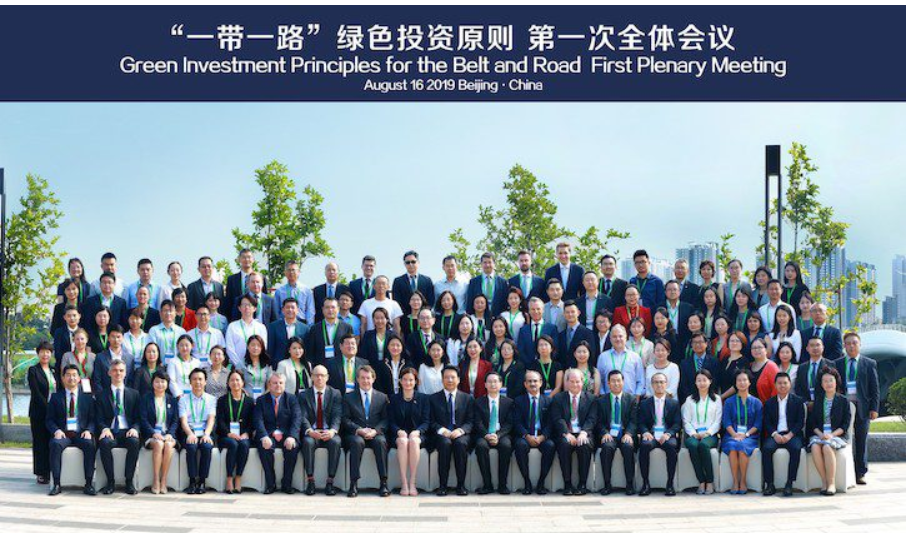The Green Investment Principle (GIP) is a set of principles for greening investment in the Belt and Road. It was co-initiated by the Green Finance Committee of China Society for Finance and Banking and the City of London Corporation’s Green Finance Initiative, with the participation of Principles for Responsible Investment, Belt & Road Bankers Roundtable, Green Belt and Road Investors Alliance, World Economic Forum, and the Paulson Institute.
The GIP was first published in London in November 2018. As of April 25, 2019, the day of its signing ceremony, 27 global institutions have signed up to GIP for the Belt and Road. By June 2021, the GIP expanded its membership to 39 signatories and 11 supporters from 14 countries and regions around the world.

The GIP includes seven principles at three levels, i.e. strategy, operations, and innovation:
Principle 1: Embedding sustainability into corporate governance
Principle 2: Understanding Environmental, Social, and Governance Risks
Principle 3: Disclosing environmental information
Principle 4: Enhancing communication with stakeholders
Principle 5: Utilizing green financial instruments
Principle 6: Adopting green supply chain management
Principle 7: Building capacity through collective action
Principle 1 and Principle 2 are designed to encourage signatories to incorporate sustainability and ESG factors into corporate strategies and management systems, aiming to call for implementation starting from the highest level and throughout the whole organization whenever possible. Principle 3 and Principle 4 focus on communication with stakeholders at the operational level. Specific measures that signatories could take to contain environmental and social risks include environmental risk analysis, information sharing, and conflict resolution mechanisms. Principles 5 to 7 are set to encourage signatories to utilize cutting-edge green financial instruments and green supply chain practices, and to improve organizational capacity through knowledge sharing and collective actions.
The GIP signatories are expected to incorporate the principles into their corporate strategy and decision-making processes and are invited to report regularly on their performance to the GIP Secretariat. The latest performance report published in September 2020 evaluated data provided by 23 signatories under the four reporting themes, i.e. Governance and Strategy, Risk Management and Assessment, Investment and Corporate Footprint, and Disclosure and Engagement. The report revealed that the majority of signatories acknowledge E&S issues and related risks in corporate governance and most have developed and published a sustainability strategy. Over half of the signatories describes the governance and systems for managing E&S risks, including risk reporting is provided up to the investment committee, and areas of operational risk management. However, the signatories are less advanced in terms of disclosing portfolio information, which to a large extent, mirrors maturity on the three other reporting areas. The transition pathways still remain nascent and the green investment targets are patchy.
Based on the Report findings, the report also set up a three-year plan “Vision 2023”, which focuses on five key pillars – assess, disclose, commit, invest, and grow. Under this vision, all members are expected to have made their first TCFD disclosure by 2023.
Annex: List of Signatories of the GIP
(last updated on April 30, 2021)
| No. | Signaturies | Country |
| 1 | Agricultural Bank of China | China |
| 2 | Agricultural Development Bank of China | China |
| 3 | Al Hilal Bank | United Arab Emirates |
| 4 | Ant Financial Services Group | China |
| 5 | Astana International Exchange | Kazakhstan |
| 6 | Bank of Bangkok | Bangkok |
| 7 | Bank of China | China |
| 8 | Bank of East Asia | China |
| 9 | BMCE Bank of Africa | Morocco, Africa |
| 10 | BNP Paribas | France |
| 11 | China Construction Bank | China |
| 12 | China Development Bank | China |
| 13 | China International Capital Corporation | China |
| 14 | China International Contractors Association | China |
| 15 | China Merchants Port Holdings Corporation | China |
| 16 | Commerzbank AG | Germany |
| 17 | Crédit Agricole-CIB | France |
| 18 | DBS Bank | Singapore |
| 19 | Deutsche Bank | Germany |
| 20 | Export-Import Bank of China | China |
| 21 | First Abu Dhabi Bank | United Arab Emirates |
| 22 | Habib Bank of Pakistan | Pakistan |
| 23 | Hong Kong and Shanghai Banking Corporation Limited (HSBC) | China |
| 24 | Hong Kong Exchanges and Clearing | China |
| 25 | Industrial and Commercial Bank of China | China |
| 26 | Industrial Bank | U.S. |
| 27 | Khan Bank | Mongolia |
| 28 | Luxembourg Stock Exchange | Luxembourg |
| 29 | Mizuho Bank | Japan |
| 30 | Natixis Bank | France |
| 31 | Ping An Insurance (GROUP) Company Of China | China |
| 32 | Silk Road Fund | China |
| 33 | Société Générale | France |
| 34 | Standard Chartered Bank | U.K. |
| 35 | Trade and Development Bank of Mongolia | Mongolia |
| 36 | UBS Group AG | Switzerland |
| 37 | Xinjiang Goldwind Science & Technology | China |
| 38 | Swiss Re Group | Switzerland |
| 39 | China Re Group | China |